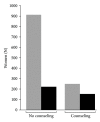Predictors of postpartum glucose tolerance testing in italian women with gestational diabetes mellitus
- PMID: 23956870
- PMCID: PMC3730210
- DOI: 10.1155/2013/182505
Predictors of postpartum glucose tolerance testing in italian women with gestational diabetes mellitus
Abstract
Postpartum screening is critical for early identification of type 2 diabetes in women previously diagnosed with gestational diabetes mellitus (GDM). Nevertheless, its rate remains disappointingly low. Thus, we plan to examine the rate of postpartum glucose tolerance test (ppOGTT) for Italian women with GDM, before and after counseling, and identify demographic, clinical, and/or biochemical predictors of adherence. With these aims, we retrospectively enrolled 1159 women with GDM, in Calabria, Southern Italy, between 2004 and 2011. During the last year, verbal and written counseling on the importance of followup was introduced. Data were analyzed by multiple regression analysis. A significant increase of the return rate was observed following introduction of the counseling [adjusted odds ratio (AOR) 5.17 (95% CI, 3.83-6.97), P < 0.001]. Interestingly, previous diagnosis of polycystic ovary syndrome (PCOS) emerged as the major predictor of postpartum followup [AOR 5.27 (95% CI, 3.51-8.70), P < 0.001], even after stratification for the absence of counseling. Previous diagnosis of GDM, higher educational status, and insulin treatment were also relevant predictors. Overall, our data indicate that counseling intervention is effective, even if many women fail to return, whereas PCOS represents a new strong predictor of adherence to postpartum testing.
Figures
References
-
- Lipscombe LL, Hux JE. Trends in diabetes prevalence, incidence, and mortality in Ontario, Canada 1995–2005: a population-based study. The Lancet. 2007;369(9563):750–756. - PubMed
-
- Lawrence JM, Contreras R, Chen W, Sacks DA. Trends in the prevalence of preexisting diabetes and gestational diabetes mellitus among a racially/ethnically diverse population of pregnant women, 1999–2005. Diabetes Care. 2008;31(5):899–904. - PubMed
-
- Ferrara A, Kahn HS, Quesenberry CP, Riley C, Hedderson MM. An increase in the incidence of gestational diabetes mellitus: Northern California, 1991–2000. Obstetrics & Gynecology. 2004;103(4):526–533. - PubMed
LinkOut - more resources
Full Text Sources
Other Literature Sources


